Case Study of Electrolyte Disorder Assignment
VerifiedAdded on 2022/09/14
|11
|2544
|28
AI Summary
Contribute Materials
Your contribution can guide someone’s learning journey. Share your
documents today.

Running head: CASE STUDY
Case Study
Name of the Student
Name of the University
Author Note
Case Study
Name of the Student
Name of the University
Author Note
Secure Best Marks with AI Grader
Need help grading? Try our AI Grader for instant feedback on your assignments.
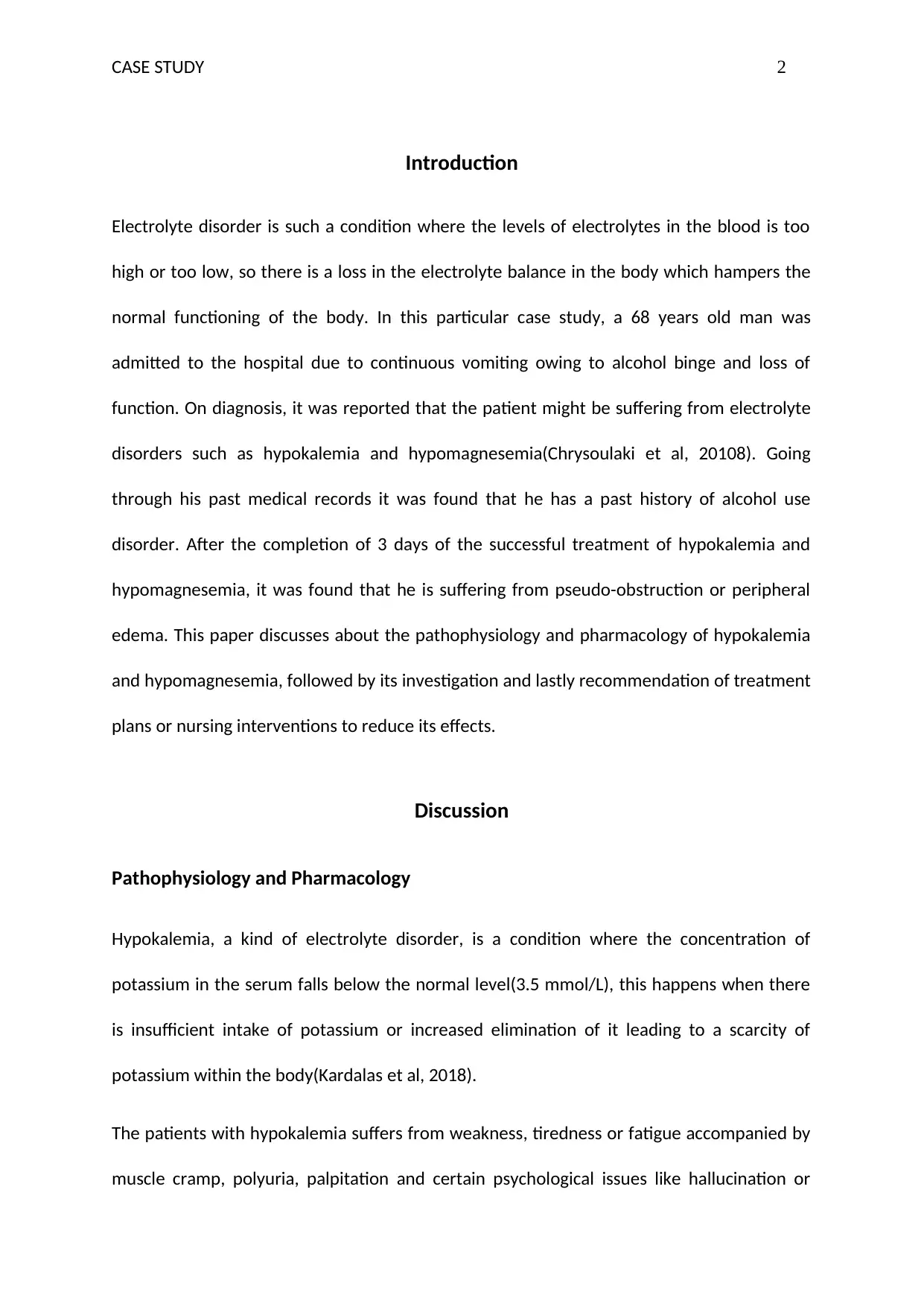
CASE STUDY 2
Introduction
Electrolyte disorder is such a condition where the levels of electrolytes in the blood is too
high or too low, so there is a loss in the electrolyte balance in the body which hampers the
normal functioning of the body. In this particular case study, a 68 years old man was
admitted to the hospital due to continuous vomiting owing to alcohol binge and loss of
function. On diagnosis, it was reported that the patient might be suffering from electrolyte
disorders such as hypokalemia and hypomagnesemia(Chrysoulaki et al, 20108). Going
through his past medical records it was found that he has a past history of alcohol use
disorder. After the completion of 3 days of the successful treatment of hypokalemia and
hypomagnesemia, it was found that he is suffering from pseudo-obstruction or peripheral
edema. This paper discusses about the pathophysiology and pharmacology of hypokalemia
and hypomagnesemia, followed by its investigation and lastly recommendation of treatment
plans or nursing interventions to reduce its effects.
Discussion
Pathophysiology and Pharmacology
Hypokalemia, a kind of electrolyte disorder, is a condition where the concentration of
potassium in the serum falls below the normal level(3.5 mmol/L), this happens when there
is insufficient intake of potassium or increased elimination of it leading to a scarcity of
potassium within the body(Kardalas et al, 2018).
The patients with hypokalemia suffers from weakness, tiredness or fatigue accompanied by
muscle cramp, polyuria, palpitation and certain psychological issues like hallucination or
Introduction
Electrolyte disorder is such a condition where the levels of electrolytes in the blood is too
high or too low, so there is a loss in the electrolyte balance in the body which hampers the
normal functioning of the body. In this particular case study, a 68 years old man was
admitted to the hospital due to continuous vomiting owing to alcohol binge and loss of
function. On diagnosis, it was reported that the patient might be suffering from electrolyte
disorders such as hypokalemia and hypomagnesemia(Chrysoulaki et al, 20108). Going
through his past medical records it was found that he has a past history of alcohol use
disorder. After the completion of 3 days of the successful treatment of hypokalemia and
hypomagnesemia, it was found that he is suffering from pseudo-obstruction or peripheral
edema. This paper discusses about the pathophysiology and pharmacology of hypokalemia
and hypomagnesemia, followed by its investigation and lastly recommendation of treatment
plans or nursing interventions to reduce its effects.
Discussion
Pathophysiology and Pharmacology
Hypokalemia, a kind of electrolyte disorder, is a condition where the concentration of
potassium in the serum falls below the normal level(3.5 mmol/L), this happens when there
is insufficient intake of potassium or increased elimination of it leading to a scarcity of
potassium within the body(Kardalas et al, 2018).
The patients with hypokalemia suffers from weakness, tiredness or fatigue accompanied by
muscle cramp, polyuria, palpitation and certain psychological issues like hallucination or
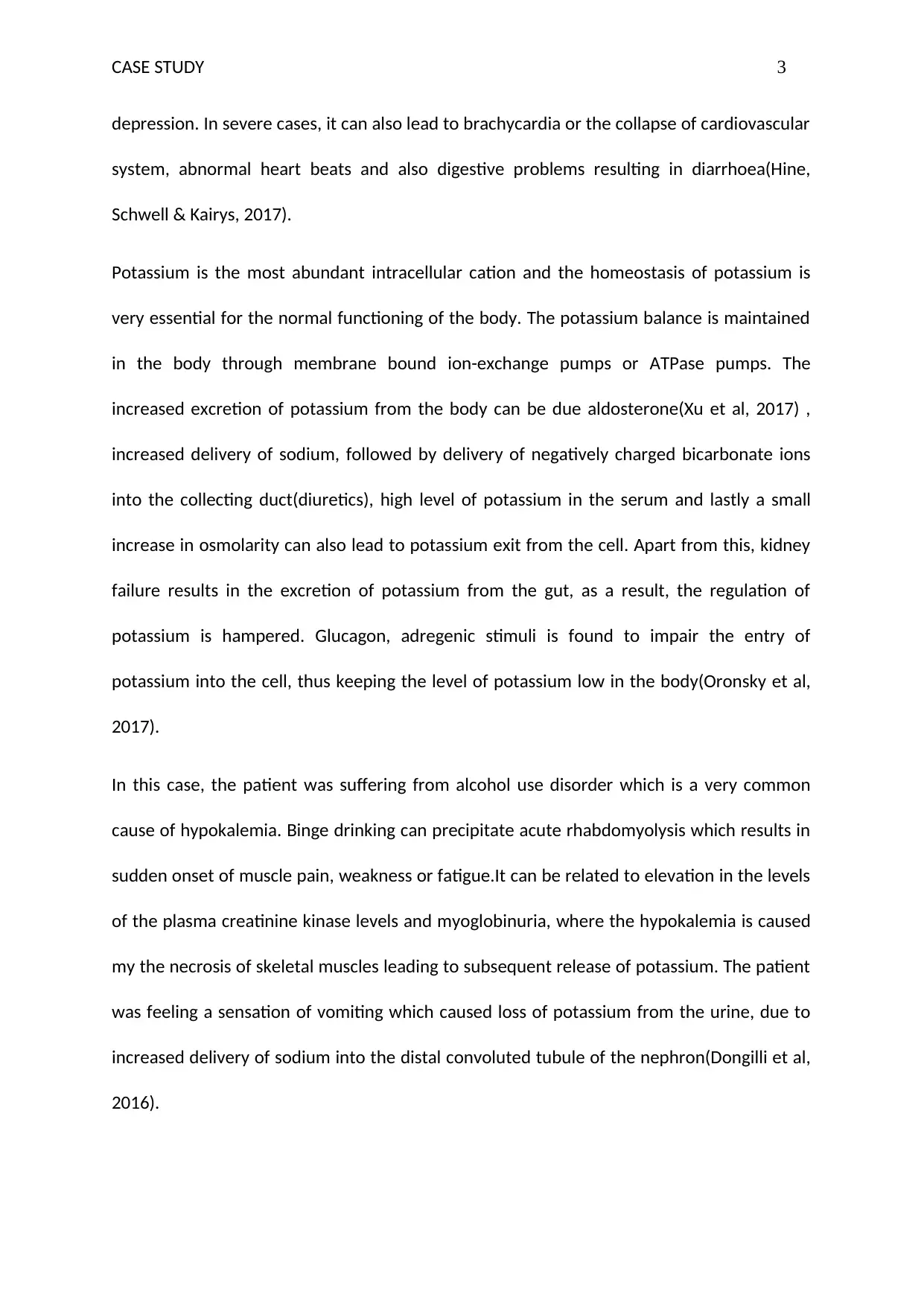
CASE STUDY 3
depression. In severe cases, it can also lead to brachycardia or the collapse of cardiovascular
system, abnormal heart beats and also digestive problems resulting in diarrhoea(Hine,
Schwell & Kairys, 2017).
Potassium is the most abundant intracellular cation and the homeostasis of potassium is
very essential for the normal functioning of the body. The potassium balance is maintained
in the body through membrane bound ion-exchange pumps or ATPase pumps. The
increased excretion of potassium from the body can be due aldosterone(Xu et al, 2017) ,
increased delivery of sodium, followed by delivery of negatively charged bicarbonate ions
into the collecting duct(diuretics), high level of potassium in the serum and lastly a small
increase in osmolarity can also lead to potassium exit from the cell. Apart from this, kidney
failure results in the excretion of potassium from the gut, as a result, the regulation of
potassium is hampered. Glucagon, adregenic stimuli is found to impair the entry of
potassium into the cell, thus keeping the level of potassium low in the body(Oronsky et al,
2017).
In this case, the patient was suffering from alcohol use disorder which is a very common
cause of hypokalemia. Binge drinking can precipitate acute rhabdomyolysis which results in
sudden onset of muscle pain, weakness or fatigue.It can be related to elevation in the levels
of the plasma creatinine kinase levels and myoglobinuria, where the hypokalemia is caused
my the necrosis of skeletal muscles leading to subsequent release of potassium. The patient
was feeling a sensation of vomiting which caused loss of potassium from the urine, due to
increased delivery of sodium into the distal convoluted tubule of the nephron(Dongilli et al,
2016).
depression. In severe cases, it can also lead to brachycardia or the collapse of cardiovascular
system, abnormal heart beats and also digestive problems resulting in diarrhoea(Hine,
Schwell & Kairys, 2017).
Potassium is the most abundant intracellular cation and the homeostasis of potassium is
very essential for the normal functioning of the body. The potassium balance is maintained
in the body through membrane bound ion-exchange pumps or ATPase pumps. The
increased excretion of potassium from the body can be due aldosterone(Xu et al, 2017) ,
increased delivery of sodium, followed by delivery of negatively charged bicarbonate ions
into the collecting duct(diuretics), high level of potassium in the serum and lastly a small
increase in osmolarity can also lead to potassium exit from the cell. Apart from this, kidney
failure results in the excretion of potassium from the gut, as a result, the regulation of
potassium is hampered. Glucagon, adregenic stimuli is found to impair the entry of
potassium into the cell, thus keeping the level of potassium low in the body(Oronsky et al,
2017).
In this case, the patient was suffering from alcohol use disorder which is a very common
cause of hypokalemia. Binge drinking can precipitate acute rhabdomyolysis which results in
sudden onset of muscle pain, weakness or fatigue.It can be related to elevation in the levels
of the plasma creatinine kinase levels and myoglobinuria, where the hypokalemia is caused
my the necrosis of skeletal muscles leading to subsequent release of potassium. The patient
was feeling a sensation of vomiting which caused loss of potassium from the urine, due to
increased delivery of sodium into the distal convoluted tubule of the nephron(Dongilli et al,
2016).
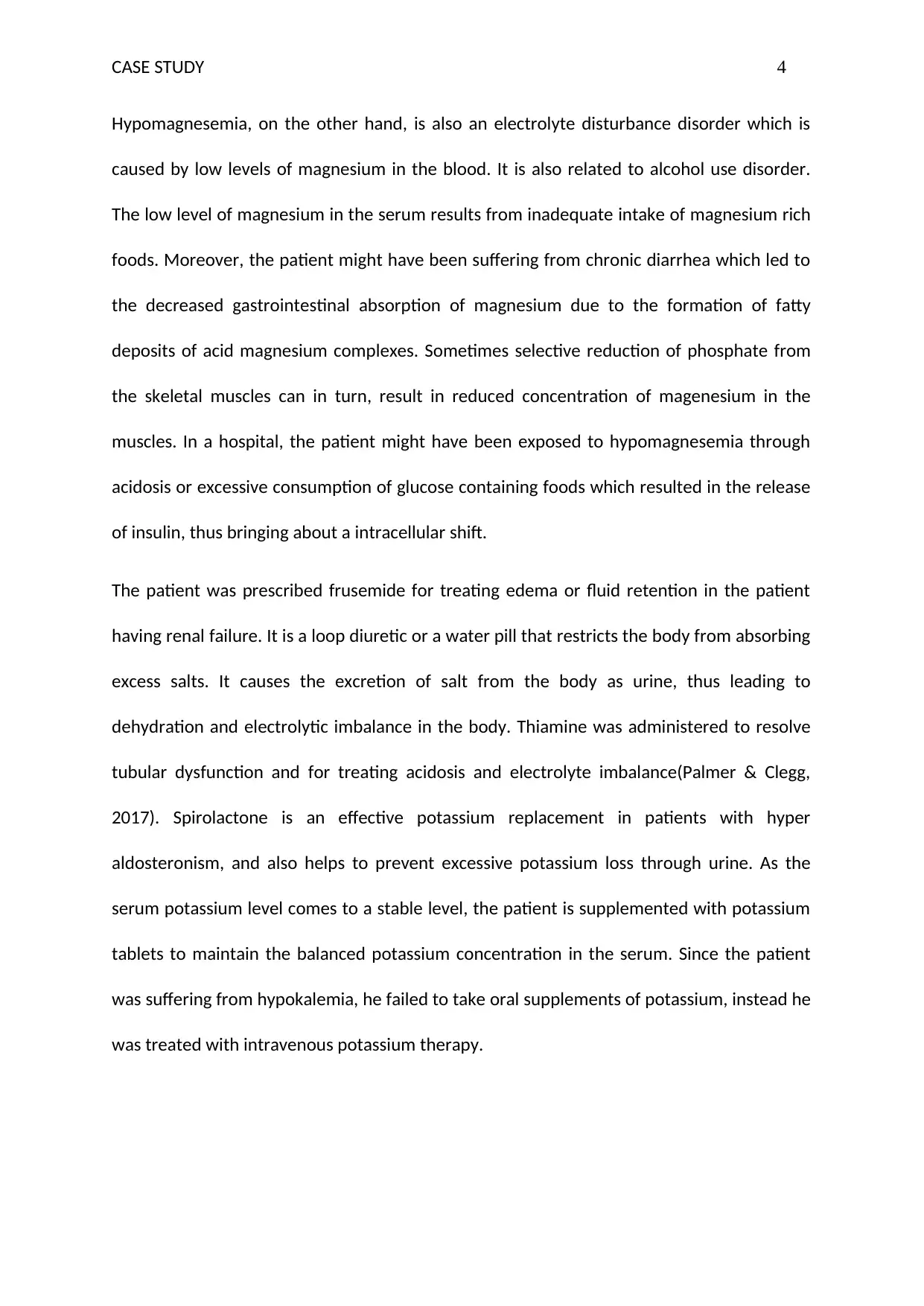
CASE STUDY 4
Hypomagnesemia, on the other hand, is also an electrolyte disturbance disorder which is
caused by low levels of magnesium in the blood. It is also related to alcohol use disorder.
The low level of magnesium in the serum results from inadequate intake of magnesium rich
foods. Moreover, the patient might have been suffering from chronic diarrhea which led to
the decreased gastrointestinal absorption of magnesium due to the formation of fatty
deposits of acid magnesium complexes. Sometimes selective reduction of phosphate from
the skeletal muscles can in turn, result in reduced concentration of magenesium in the
muscles. In a hospital, the patient might have been exposed to hypomagnesemia through
acidosis or excessive consumption of glucose containing foods which resulted in the release
of insulin, thus bringing about a intracellular shift.
The patient was prescribed frusemide for treating edema or fluid retention in the patient
having renal failure. It is a loop diuretic or a water pill that restricts the body from absorbing
excess salts. It causes the excretion of salt from the body as urine, thus leading to
dehydration and electrolytic imbalance in the body. Thiamine was administered to resolve
tubular dysfunction and for treating acidosis and electrolyte imbalance(Palmer & Clegg,
2017). Spirolactone is an effective potassium replacement in patients with hyper
aldosteronism, and also helps to prevent excessive potassium loss through urine. As the
serum potassium level comes to a stable level, the patient is supplemented with potassium
tablets to maintain the balanced potassium concentration in the serum. Since the patient
was suffering from hypokalemia, he failed to take oral supplements of potassium, instead he
was treated with intravenous potassium therapy.
Hypomagnesemia, on the other hand, is also an electrolyte disturbance disorder which is
caused by low levels of magnesium in the blood. It is also related to alcohol use disorder.
The low level of magnesium in the serum results from inadequate intake of magnesium rich
foods. Moreover, the patient might have been suffering from chronic diarrhea which led to
the decreased gastrointestinal absorption of magnesium due to the formation of fatty
deposits of acid magnesium complexes. Sometimes selective reduction of phosphate from
the skeletal muscles can in turn, result in reduced concentration of magenesium in the
muscles. In a hospital, the patient might have been exposed to hypomagnesemia through
acidosis or excessive consumption of glucose containing foods which resulted in the release
of insulin, thus bringing about a intracellular shift.
The patient was prescribed frusemide for treating edema or fluid retention in the patient
having renal failure. It is a loop diuretic or a water pill that restricts the body from absorbing
excess salts. It causes the excretion of salt from the body as urine, thus leading to
dehydration and electrolytic imbalance in the body. Thiamine was administered to resolve
tubular dysfunction and for treating acidosis and electrolyte imbalance(Palmer & Clegg,
2017). Spirolactone is an effective potassium replacement in patients with hyper
aldosteronism, and also helps to prevent excessive potassium loss through urine. As the
serum potassium level comes to a stable level, the patient is supplemented with potassium
tablets to maintain the balanced potassium concentration in the serum. Since the patient
was suffering from hypokalemia, he failed to take oral supplements of potassium, instead he
was treated with intravenous potassium therapy.
Secure Best Marks with AI Grader
Need help grading? Try our AI Grader for instant feedback on your assignments.
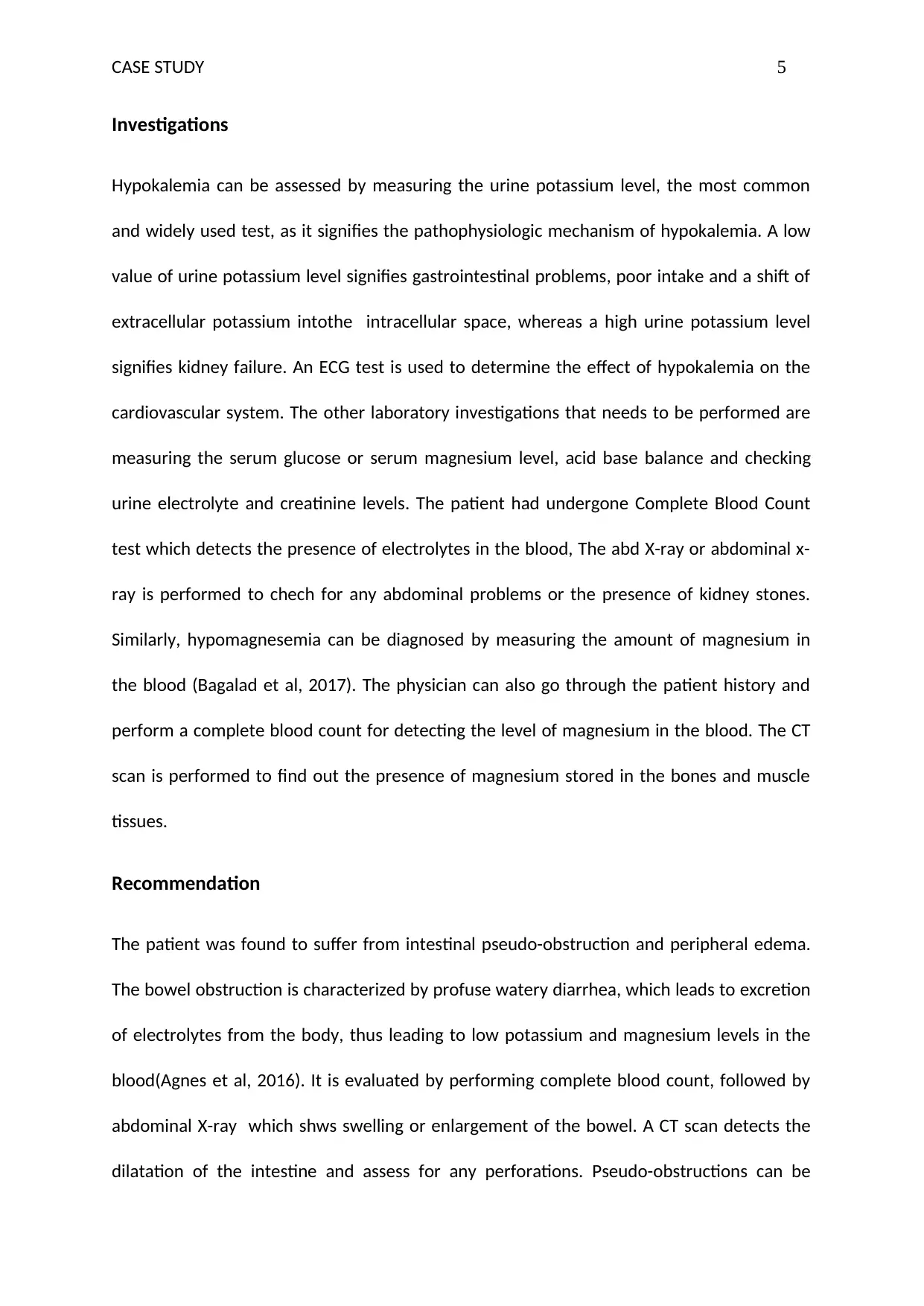
CASE STUDY 5
Investigations
Hypokalemia can be assessed by measuring the urine potassium level, the most common
and widely used test, as it signifies the pathophysiologic mechanism of hypokalemia. A low
value of urine potassium level signifies gastrointestinal problems, poor intake and a shift of
extracellular potassium intothe intracellular space, whereas a high urine potassium level
signifies kidney failure. An ECG test is used to determine the effect of hypokalemia on the
cardiovascular system. The other laboratory investigations that needs to be performed are
measuring the serum glucose or serum magnesium level, acid base balance and checking
urine electrolyte and creatinine levels. The patient had undergone Complete Blood Count
test which detects the presence of electrolytes in the blood, The abd X-ray or abdominal x-
ray is performed to chech for any abdominal problems or the presence of kidney stones.
Similarly, hypomagnesemia can be diagnosed by measuring the amount of magnesium in
the blood (Bagalad et al, 2017). The physician can also go through the patient history and
perform a complete blood count for detecting the level of magnesium in the blood. The CT
scan is performed to find out the presence of magnesium stored in the bones and muscle
tissues.
Recommendation
The patient was found to suffer from intestinal pseudo-obstruction and peripheral edema.
The bowel obstruction is characterized by profuse watery diarrhea, which leads to excretion
of electrolytes from the body, thus leading to low potassium and magnesium levels in the
blood(Agnes et al, 2016). It is evaluated by performing complete blood count, followed by
abdominal X-ray which shws swelling or enlargement of the bowel. A CT scan detects the
dilatation of the intestine and assess for any perforations. Pseudo-obstructions can be
Investigations
Hypokalemia can be assessed by measuring the urine potassium level, the most common
and widely used test, as it signifies the pathophysiologic mechanism of hypokalemia. A low
value of urine potassium level signifies gastrointestinal problems, poor intake and a shift of
extracellular potassium intothe intracellular space, whereas a high urine potassium level
signifies kidney failure. An ECG test is used to determine the effect of hypokalemia on the
cardiovascular system. The other laboratory investigations that needs to be performed are
measuring the serum glucose or serum magnesium level, acid base balance and checking
urine electrolyte and creatinine levels. The patient had undergone Complete Blood Count
test which detects the presence of electrolytes in the blood, The abd X-ray or abdominal x-
ray is performed to chech for any abdominal problems or the presence of kidney stones.
Similarly, hypomagnesemia can be diagnosed by measuring the amount of magnesium in
the blood (Bagalad et al, 2017). The physician can also go through the patient history and
perform a complete blood count for detecting the level of magnesium in the blood. The CT
scan is performed to find out the presence of magnesium stored in the bones and muscle
tissues.
Recommendation
The patient was found to suffer from intestinal pseudo-obstruction and peripheral edema.
The bowel obstruction is characterized by profuse watery diarrhea, which leads to excretion
of electrolytes from the body, thus leading to low potassium and magnesium levels in the
blood(Agnes et al, 2016). It is evaluated by performing complete blood count, followed by
abdominal X-ray which shws swelling or enlargement of the bowel. A CT scan detects the
dilatation of the intestine and assess for any perforations. Pseudo-obstructions can be
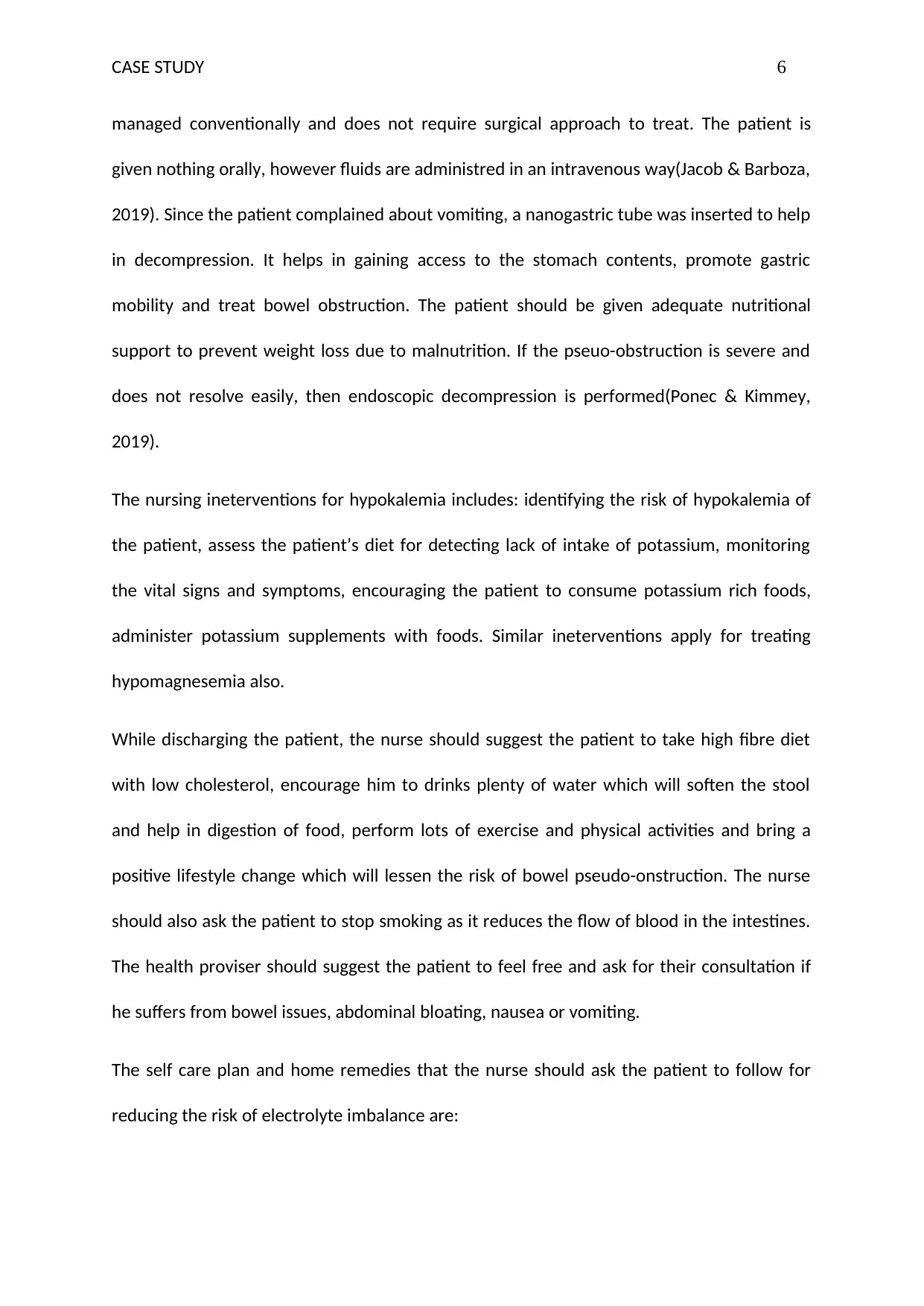
CASE STUDY 6
managed conventionally and does not require surgical approach to treat. The patient is
given nothing orally, however fluids are administred in an intravenous way(Jacob & Barboza,
2019). Since the patient complained about vomiting, a nanogastric tube was inserted to help
in decompression. It helps in gaining access to the stomach contents, promote gastric
mobility and treat bowel obstruction. The patient should be given adequate nutritional
support to prevent weight loss due to malnutrition. If the pseuo-obstruction is severe and
does not resolve easily, then endoscopic decompression is performed(Ponec & Kimmey,
2019).
The nursing ineterventions for hypokalemia includes: identifying the risk of hypokalemia of
the patient, assess the patient’s diet for detecting lack of intake of potassium, monitoring
the vital signs and symptoms, encouraging the patient to consume potassium rich foods,
administer potassium supplements with foods. Similar ineterventions apply for treating
hypomagnesemia also.
While discharging the patient, the nurse should suggest the patient to take high fibre diet
with low cholesterol, encourage him to drinks plenty of water which will soften the stool
and help in digestion of food, perform lots of exercise and physical activities and bring a
positive lifestyle change which will lessen the risk of bowel pseudo-onstruction. The nurse
should also ask the patient to stop smoking as it reduces the flow of blood in the intestines.
The health proviser should suggest the patient to feel free and ask for their consultation if
he suffers from bowel issues, abdominal bloating, nausea or vomiting.
The self care plan and home remedies that the nurse should ask the patient to follow for
reducing the risk of electrolyte imbalance are:
managed conventionally and does not require surgical approach to treat. The patient is
given nothing orally, however fluids are administred in an intravenous way(Jacob & Barboza,
2019). Since the patient complained about vomiting, a nanogastric tube was inserted to help
in decompression. It helps in gaining access to the stomach contents, promote gastric
mobility and treat bowel obstruction. The patient should be given adequate nutritional
support to prevent weight loss due to malnutrition. If the pseuo-obstruction is severe and
does not resolve easily, then endoscopic decompression is performed(Ponec & Kimmey,
2019).
The nursing ineterventions for hypokalemia includes: identifying the risk of hypokalemia of
the patient, assess the patient’s diet for detecting lack of intake of potassium, monitoring
the vital signs and symptoms, encouraging the patient to consume potassium rich foods,
administer potassium supplements with foods. Similar ineterventions apply for treating
hypomagnesemia also.
While discharging the patient, the nurse should suggest the patient to take high fibre diet
with low cholesterol, encourage him to drinks plenty of water which will soften the stool
and help in digestion of food, perform lots of exercise and physical activities and bring a
positive lifestyle change which will lessen the risk of bowel pseudo-onstruction. The nurse
should also ask the patient to stop smoking as it reduces the flow of blood in the intestines.
The health proviser should suggest the patient to feel free and ask for their consultation if
he suffers from bowel issues, abdominal bloating, nausea or vomiting.
The self care plan and home remedies that the nurse should ask the patient to follow for
reducing the risk of electrolyte imbalance are:
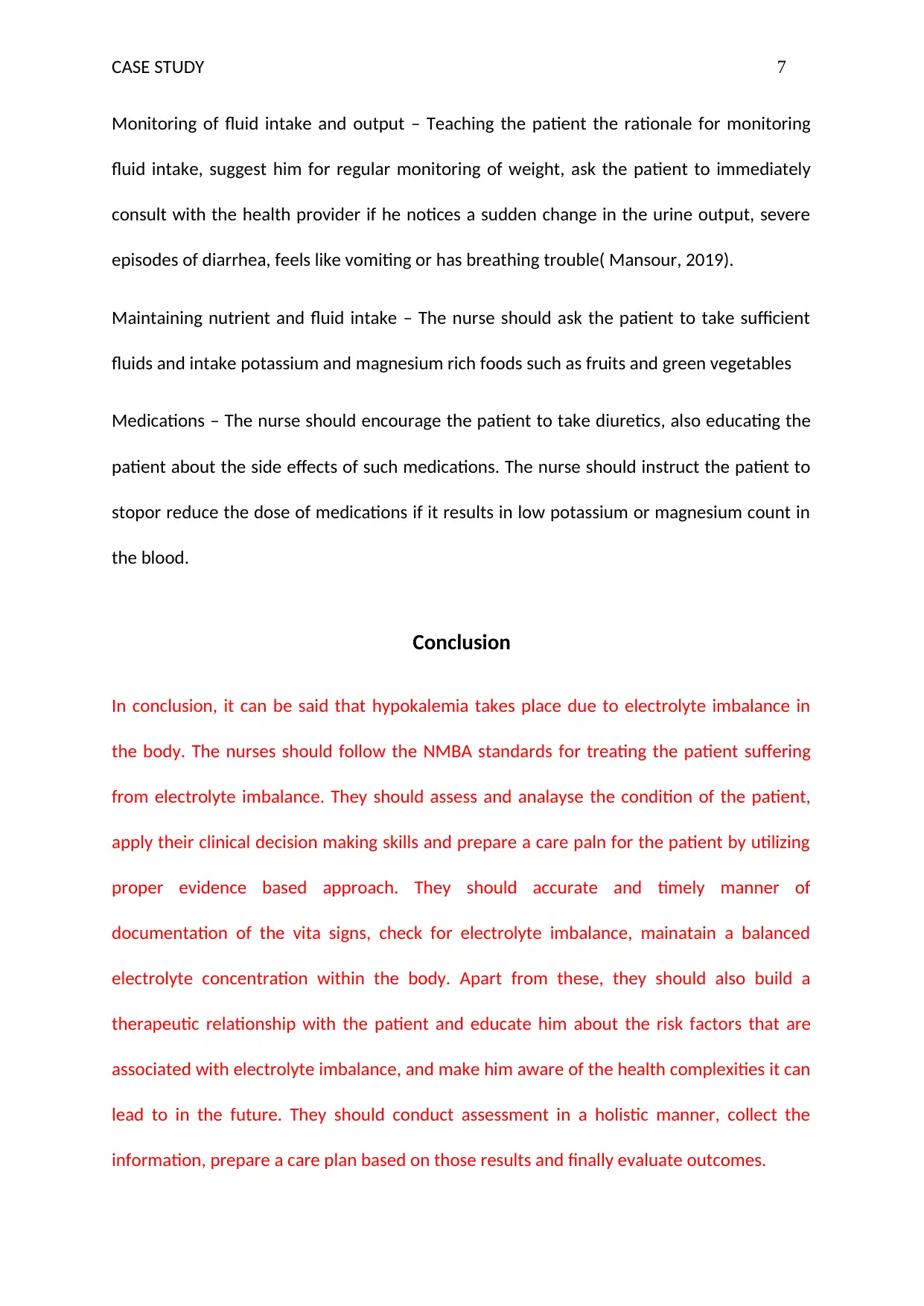
CASE STUDY 7
Monitoring of fluid intake and output – Teaching the patient the rationale for monitoring
fluid intake, suggest him for regular monitoring of weight, ask the patient to immediately
consult with the health provider if he notices a sudden change in the urine output, severe
episodes of diarrhea, feels like vomiting or has breathing trouble( Mansour, 2019).
Maintaining nutrient and fluid intake – The nurse should ask the patient to take sufficient
fluids and intake potassium and magnesium rich foods such as fruits and green vegetables
Medications – The nurse should encourage the patient to take diuretics, also educating the
patient about the side effects of such medications. The nurse should instruct the patient to
stopor reduce the dose of medications if it results in low potassium or magnesium count in
the blood.
Conclusion
In conclusion, it can be said that hypokalemia takes place due to electrolyte imbalance in
the body. The nurses should follow the NMBA standards for treating the patient suffering
from electrolyte imbalance. They should assess and analayse the condition of the patient,
apply their clinical decision making skills and prepare a care paln for the patient by utilizing
proper evidence based approach. They should accurate and timely manner of
documentation of the vita signs, check for electrolyte imbalance, mainatain a balanced
electrolyte concentration within the body. Apart from these, they should also build a
therapeutic relationship with the patient and educate him about the risk factors that are
associated with electrolyte imbalance, and make him aware of the health complexities it can
lead to in the future. They should conduct assessment in a holistic manner, collect the
information, prepare a care plan based on those results and finally evaluate outcomes.
Monitoring of fluid intake and output – Teaching the patient the rationale for monitoring
fluid intake, suggest him for regular monitoring of weight, ask the patient to immediately
consult with the health provider if he notices a sudden change in the urine output, severe
episodes of diarrhea, feels like vomiting or has breathing trouble( Mansour, 2019).
Maintaining nutrient and fluid intake – The nurse should ask the patient to take sufficient
fluids and intake potassium and magnesium rich foods such as fruits and green vegetables
Medications – The nurse should encourage the patient to take diuretics, also educating the
patient about the side effects of such medications. The nurse should instruct the patient to
stopor reduce the dose of medications if it results in low potassium or magnesium count in
the blood.
Conclusion
In conclusion, it can be said that hypokalemia takes place due to electrolyte imbalance in
the body. The nurses should follow the NMBA standards for treating the patient suffering
from electrolyte imbalance. They should assess and analayse the condition of the patient,
apply their clinical decision making skills and prepare a care paln for the patient by utilizing
proper evidence based approach. They should accurate and timely manner of
documentation of the vita signs, check for electrolyte imbalance, mainatain a balanced
electrolyte concentration within the body. Apart from these, they should also build a
therapeutic relationship with the patient and educate him about the risk factors that are
associated with electrolyte imbalance, and make him aware of the health complexities it can
lead to in the future. They should conduct assessment in a holistic manner, collect the
information, prepare a care plan based on those results and finally evaluate outcomes.
Paraphrase This Document
Need a fresh take? Get an instant paraphrase of this document with our AI Paraphraser

CASE STUDY 8
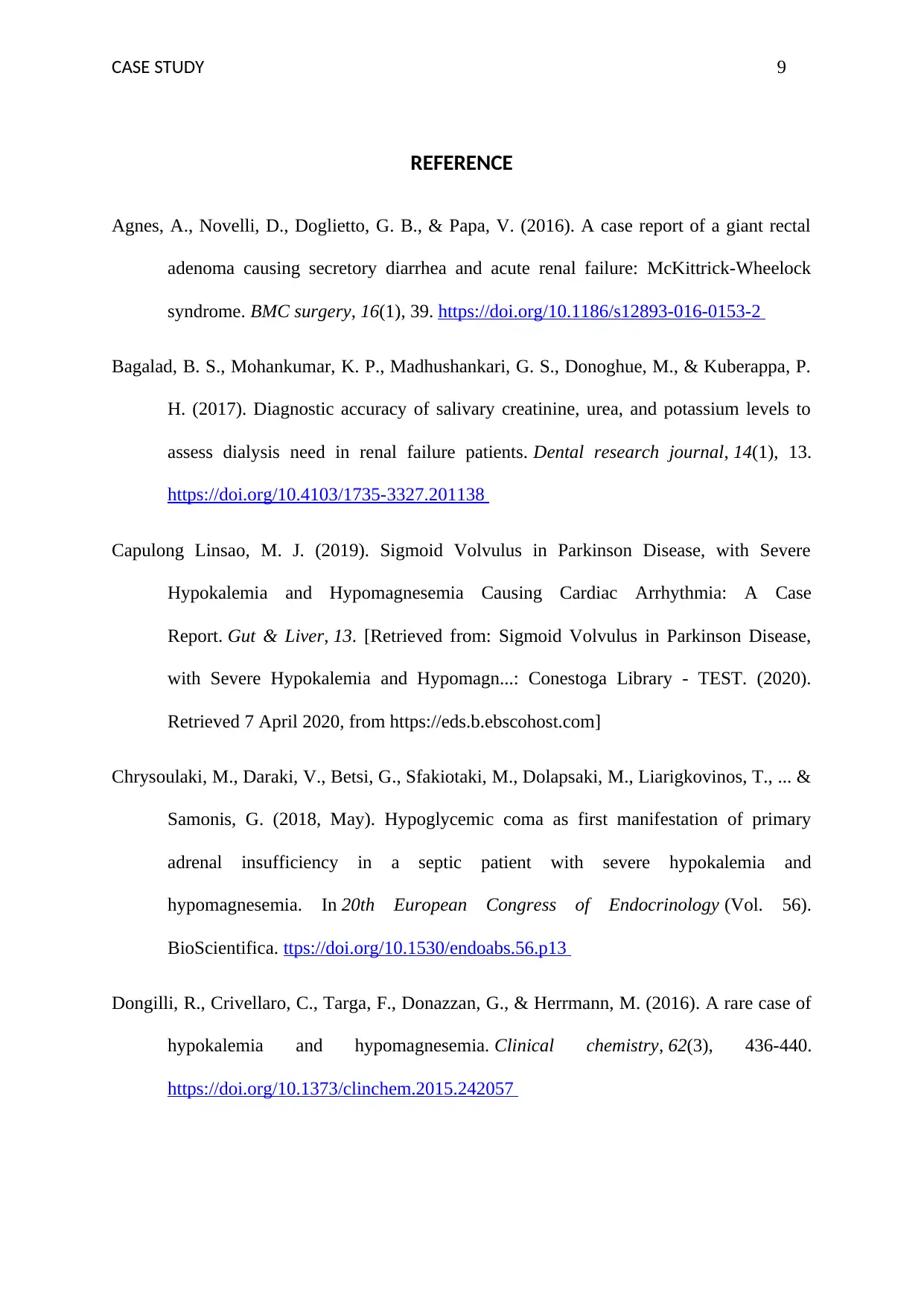
CASE STUDY 9
REFERENCE
Agnes, A., Novelli, D., Doglietto, G. B., & Papa, V. (2016). A case report of a giant rectal
adenoma causing secretory diarrhea and acute renal failure: McKittrick-Wheelock
syndrome. BMC surgery, 16(1), 39. https://doi.org/10.1186/s12893-016-0153-2
Bagalad, B. S., Mohankumar, K. P., Madhushankari, G. S., Donoghue, M., & Kuberappa, P.
H. (2017). Diagnostic accuracy of salivary creatinine, urea, and potassium levels to
assess dialysis need in renal failure patients. Dental research journal, 14(1), 13.
https://doi.org/10.4103/1735-3327.201138
Capulong Linsao, M. J. (2019). Sigmoid Volvulus in Parkinson Disease, with Severe
Hypokalemia and Hypomagnesemia Causing Cardiac Arrhythmia: A Case
Report. Gut & Liver, 13. [Retrieved from: Sigmoid Volvulus in Parkinson Disease,
with Severe Hypokalemia and Hypomagn...: Conestoga Library - TEST. (2020).
Retrieved 7 April 2020, from https://eds.b.ebscohost.com]
Chrysoulaki, M., Daraki, V., Betsi, G., Sfakiotaki, M., Dolapsaki, M., Liarigkovinos, T., ... &
Samonis, G. (2018, May). Hypoglycemic coma as first manifestation of primary
adrenal insufficiency in a septic patient with severe hypokalemia and
hypomagnesemia. In 20th European Congress of Endocrinology (Vol. 56).
BioScientifica. ttps://doi.org/10.1530/endoabs.56.p13
Dongilli, R., Crivellaro, C., Targa, F., Donazzan, G., & Herrmann, M. (2016). A rare case of
hypokalemia and hypomagnesemia. Clinical chemistry, 62(3), 436-440.
https://doi.org/10.1373/clinchem.2015.242057
REFERENCE
Agnes, A., Novelli, D., Doglietto, G. B., & Papa, V. (2016). A case report of a giant rectal
adenoma causing secretory diarrhea and acute renal failure: McKittrick-Wheelock
syndrome. BMC surgery, 16(1), 39. https://doi.org/10.1186/s12893-016-0153-2
Bagalad, B. S., Mohankumar, K. P., Madhushankari, G. S., Donoghue, M., & Kuberappa, P.
H. (2017). Diagnostic accuracy of salivary creatinine, urea, and potassium levels to
assess dialysis need in renal failure patients. Dental research journal, 14(1), 13.
https://doi.org/10.4103/1735-3327.201138
Capulong Linsao, M. J. (2019). Sigmoid Volvulus in Parkinson Disease, with Severe
Hypokalemia and Hypomagnesemia Causing Cardiac Arrhythmia: A Case
Report. Gut & Liver, 13. [Retrieved from: Sigmoid Volvulus in Parkinson Disease,
with Severe Hypokalemia and Hypomagn...: Conestoga Library - TEST. (2020).
Retrieved 7 April 2020, from https://eds.b.ebscohost.com]
Chrysoulaki, M., Daraki, V., Betsi, G., Sfakiotaki, M., Dolapsaki, M., Liarigkovinos, T., ... &
Samonis, G. (2018, May). Hypoglycemic coma as first manifestation of primary
adrenal insufficiency in a septic patient with severe hypokalemia and
hypomagnesemia. In 20th European Congress of Endocrinology (Vol. 56).
BioScientifica. ttps://doi.org/10.1530/endoabs.56.p13
Dongilli, R., Crivellaro, C., Targa, F., Donazzan, G., & Herrmann, M. (2016). A rare case of
hypokalemia and hypomagnesemia. Clinical chemistry, 62(3), 436-440.
https://doi.org/10.1373/clinchem.2015.242057
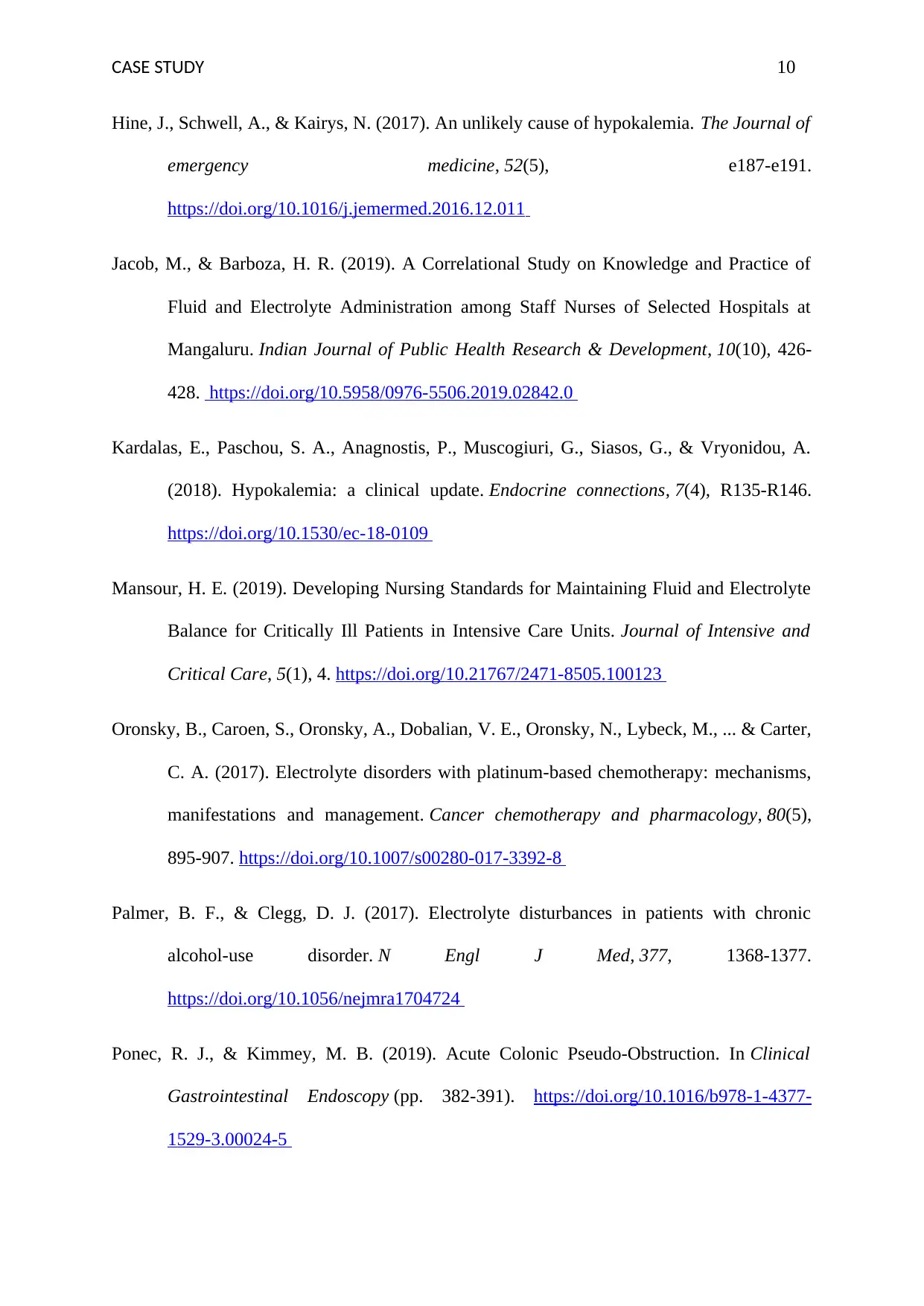
CASE STUDY 10
Hine, J., Schwell, A., & Kairys, N. (2017). An unlikely cause of hypokalemia. The Journal of
emergency medicine, 52(5), e187-e191.
https://doi.org/10.1016/j.jemermed.2016.12.011
Jacob, M., & Barboza, H. R. (2019). A Correlational Study on Knowledge and Practice of
Fluid and Electrolyte Administration among Staff Nurses of Selected Hospitals at
Mangaluru. Indian Journal of Public Health Research & Development, 10(10), 426-
428. https://doi.org/10.5958/0976-5506.2019.02842.0
Kardalas, E., Paschou, S. A., Anagnostis, P., Muscogiuri, G., Siasos, G., & Vryonidou, A.
(2018). Hypokalemia: a clinical update. Endocrine connections, 7(4), R135-R146.
https://doi.org/10.1530/ec-18-0109
Mansour, H. E. (2019). Developing Nursing Standards for Maintaining Fluid and Electrolyte
Balance for Critically Ill Patients in Intensive Care Units. Journal of Intensive and
Critical Care, 5(1), 4. https://doi.org/10.21767/2471-8505.100123
Oronsky, B., Caroen, S., Oronsky, A., Dobalian, V. E., Oronsky, N., Lybeck, M., ... & Carter,
C. A. (2017). Electrolyte disorders with platinum-based chemotherapy: mechanisms,
manifestations and management. Cancer chemotherapy and pharmacology, 80(5),
895-907. https://doi.org/10.1007/s00280-017-3392-8
Palmer, B. F., & Clegg, D. J. (2017). Electrolyte disturbances in patients with chronic
alcohol-use disorder. N Engl J Med, 377, 1368-1377.
https://doi.org/10.1056/nejmra1704724
Ponec, R. J., & Kimmey, M. B. (2019). Acute Colonic Pseudo-Obstruction. In Clinical
Gastrointestinal Endoscopy (pp. 382-391). https://doi.org/10.1016/b978-1-4377-
1529-3.00024-5
Hine, J., Schwell, A., & Kairys, N. (2017). An unlikely cause of hypokalemia. The Journal of
emergency medicine, 52(5), e187-e191.
https://doi.org/10.1016/j.jemermed.2016.12.011
Jacob, M., & Barboza, H. R. (2019). A Correlational Study on Knowledge and Practice of
Fluid and Electrolyte Administration among Staff Nurses of Selected Hospitals at
Mangaluru. Indian Journal of Public Health Research & Development, 10(10), 426-
428. https://doi.org/10.5958/0976-5506.2019.02842.0
Kardalas, E., Paschou, S. A., Anagnostis, P., Muscogiuri, G., Siasos, G., & Vryonidou, A.
(2018). Hypokalemia: a clinical update. Endocrine connections, 7(4), R135-R146.
https://doi.org/10.1530/ec-18-0109
Mansour, H. E. (2019). Developing Nursing Standards for Maintaining Fluid and Electrolyte
Balance for Critically Ill Patients in Intensive Care Units. Journal of Intensive and
Critical Care, 5(1), 4. https://doi.org/10.21767/2471-8505.100123
Oronsky, B., Caroen, S., Oronsky, A., Dobalian, V. E., Oronsky, N., Lybeck, M., ... & Carter,
C. A. (2017). Electrolyte disorders with platinum-based chemotherapy: mechanisms,
manifestations and management. Cancer chemotherapy and pharmacology, 80(5),
895-907. https://doi.org/10.1007/s00280-017-3392-8
Palmer, B. F., & Clegg, D. J. (2017). Electrolyte disturbances in patients with chronic
alcohol-use disorder. N Engl J Med, 377, 1368-1377.
https://doi.org/10.1056/nejmra1704724
Ponec, R. J., & Kimmey, M. B. (2019). Acute Colonic Pseudo-Obstruction. In Clinical
Gastrointestinal Endoscopy (pp. 382-391). https://doi.org/10.1016/b978-1-4377-
1529-3.00024-5
Secure Best Marks with AI Grader
Need help grading? Try our AI Grader for instant feedback on your assignments.
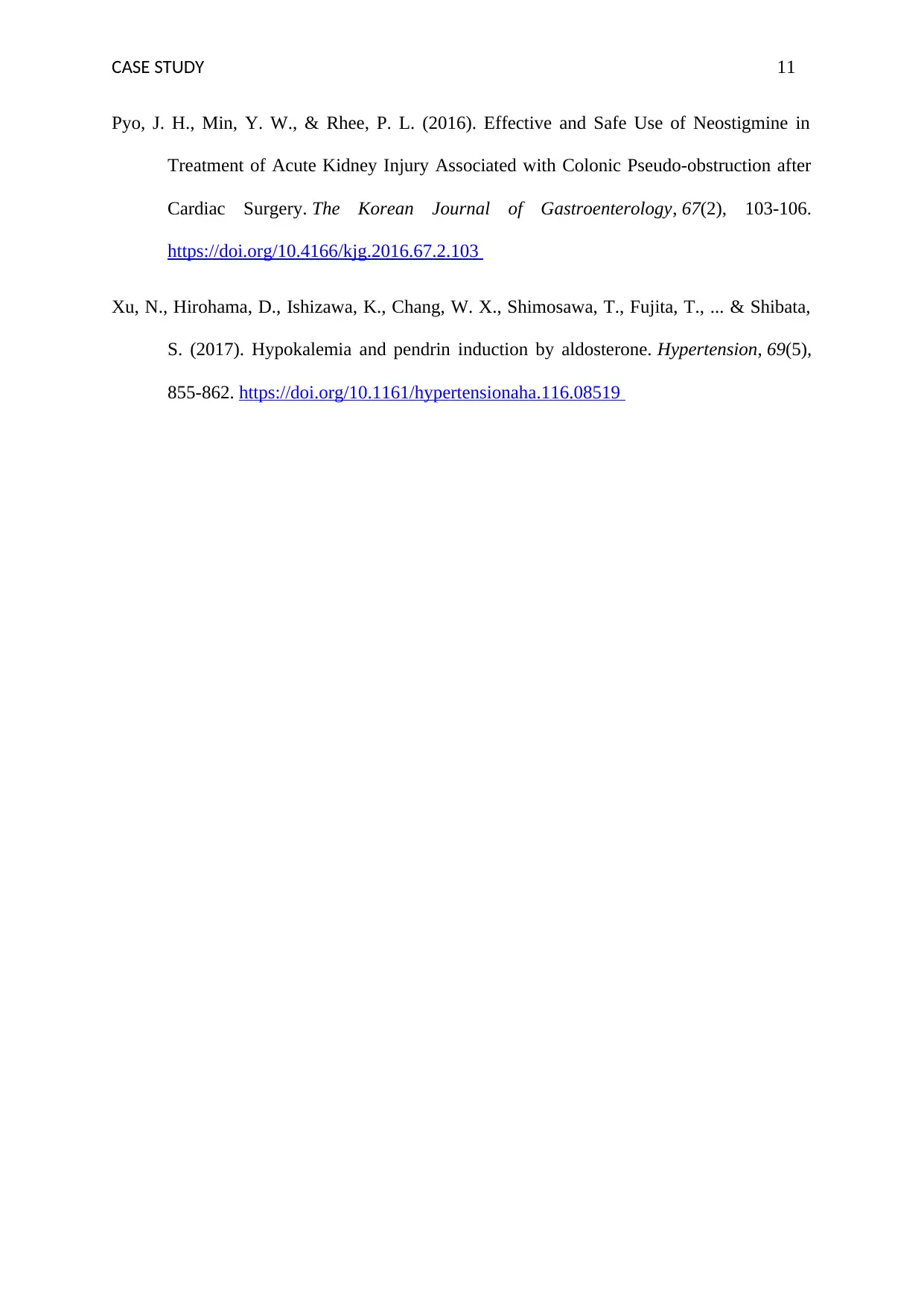
CASE STUDY 11
Pyo, J. H., Min, Y. W., & Rhee, P. L. (2016). Effective and Safe Use of Neostigmine in
Treatment of Acute Kidney Injury Associated with Colonic Pseudo-obstruction after
Cardiac Surgery. The Korean Journal of Gastroenterology, 67(2), 103-106.
https://doi.org/10.4166/kjg.2016.67.2.103
Xu, N., Hirohama, D., Ishizawa, K., Chang, W. X., Shimosawa, T., Fujita, T., ... & Shibata,
S. (2017). Hypokalemia and pendrin induction by aldosterone. Hypertension, 69(5),
855-862. https://doi.org/10.1161/hypertensionaha.116.08519
Pyo, J. H., Min, Y. W., & Rhee, P. L. (2016). Effective and Safe Use of Neostigmine in
Treatment of Acute Kidney Injury Associated with Colonic Pseudo-obstruction after
Cardiac Surgery. The Korean Journal of Gastroenterology, 67(2), 103-106.
https://doi.org/10.4166/kjg.2016.67.2.103
Xu, N., Hirohama, D., Ishizawa, K., Chang, W. X., Shimosawa, T., Fujita, T., ... & Shibata,
S. (2017). Hypokalemia and pendrin induction by aldosterone. Hypertension, 69(5),
855-862. https://doi.org/10.1161/hypertensionaha.116.08519
1 out of 11
Related Documents
Your All-in-One AI-Powered Toolkit for Academic Success.
+13062052269
info@desklib.com
Available 24*7 on WhatsApp / Email
![[object Object]](/_next/static/media/star-bottom.7253800d.svg)
Unlock your academic potential
© 2024 | Zucol Services PVT LTD | All rights reserved.





